Musculoskeletal disorders, or MSDs for short, comprise a range of physical ailments that can occur in the workplace. A sore neck, pinched shoulders, tennis elbow or sore wrists… we all know a colleague or the other who suffers from it. Fortunately, there are simple tools and tips to prevent MSDs. Here we look at how best to organise your workplace and what tools can make your efforts as light as possible. Here’s to your health!
What causes MSDs?
Where do MSDs come from? The human body totals some 650 muscles, 200 bones and 100 joints. It is therefore not surprising that a setback can sometimes occur. Musculoskeletal disorders usually occur after:
Musculoskeletal disorders occur after
- having lifted or moved (excessively) heavy loads.
- having stood or sat in the same position for too long.
- have adopted poor posture, for example, hunched back.
- having worked in an environment that was too cold or too hot.
- have repeatedly performed actions that always involve the same muscles or joints.
What are the consequences of MSDs?
MSDs can lead to different types of illnesses and diseases. It is important to know that musculoskeletal disorders are progressive. Something that looks harmless will get worse over time if you don’t do something about it. Even during periods of rest, you can suffer from it. As soon as the first symptoms appear, it is necessary to act and find the cause. MSDs can lead to the following types of physical discomfort and injury:
Second hand
- Back pain caused by poor posture or lifting heavy objects.
- Pain in the wrists caused by repetitive motions such as wringing out a mop or using a computer mouse.
- Pain in the elbows due to repetitive movements.
- Pain in the legs due to lack of movement or variation.
In addition to these physical complaints, MSDs also cause a financial burden. Firstly, for the companies concerned due to increased absenteeism and the additional workload for other colleagues. Secondly, for society due to the increased costs of illness, unemployment, etc.
Secondly, for society due to the increased costs of illness, unemployment, etc.


Take a look at the complete overview of RAJA ergonomic products at our online shop or in our catalogue. There you will find numerous solutions for your office, warehouse or shop. You can always easily recognise these products thanks to the "MSD Prevention" logo.
10 tips to prevent MSDs in the workplace
The following list of tools and improvements can help prevent MSDs. Whether you are working at a desk or moving around a warehouse, you will find that a few simple adjustments can be very helpful.
► 1. Choose the right sitting position at your desk
For those who have to spend many hours each day in an office chair, good sitting posture is crucial. Here are some tips to make sitting more comfortable and ergonomic:
- [1]Place the top edge of your screen at eye level if you are looking straight ahead. The distance to your screen should be equivalent to the length of your arm.
- [2] Provide a dynamic chair in which the backrest can move along with the seat. This means that your back is always supported. In addition, provide a backrest that can follow the natural curve of your back.
- [3] Adjust the desk and armrests to elbow height.
- [4] The height of the seat should match the height of the knee. To do this, bend the knee at a 90° angle and let the feet rest flat on the floor.
- [5] Make sure there's enough room between the seat and the hollow of your knee. Leaving the size of a fist free will prevent pinching the hollow of the knee and not blocking nerves or blood vessels.
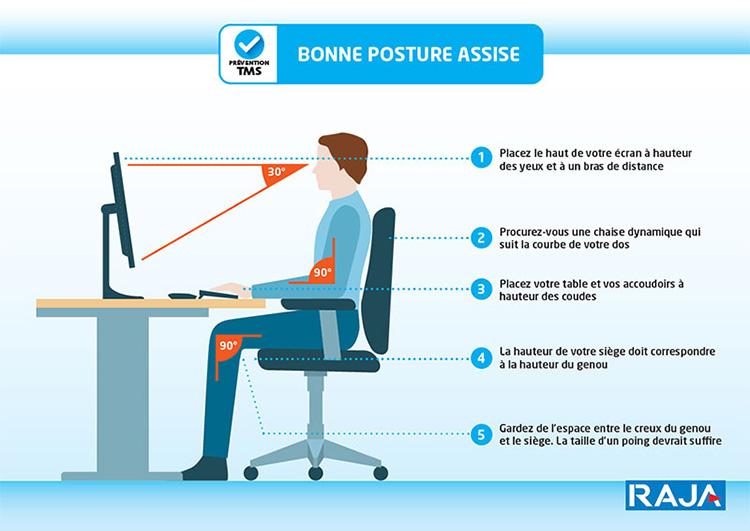
► 2. Set your table at the right height
This tip is for people who have to work standing at a table. Think about a packing station, for example. It is therefore essential to work at the right height to avoid RSI. If you work too low, you have to bend your trunk, neck and back too much. A work surface that is too high, on the other hand, may require you to lift your arms and shoulders too much to complete the task. This should also be avoided.
.
The diagram below shows the best height for placing your table. Good to know: allow enough free space under the worktop for your feet and knees. This way you will not be hindered in your movements. You should also consider installing a high stool (or sit-stand chair). It is best to place the seat at an angle of'about 15°. This will make it easier for you to change positions.
.
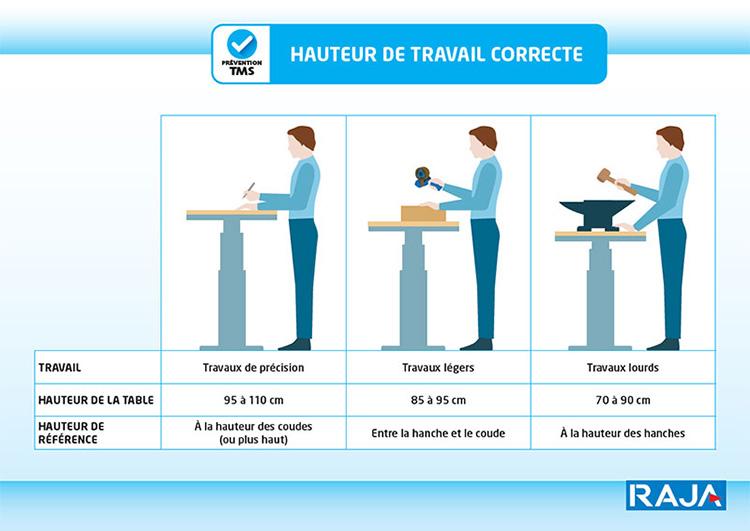
► 3. Reduce the horizontal grip distance
Tools or office equipment that are regularly needed should be within easy reach. It is particularly useful to know this when setting up a packing table. Two distances play a role here:
- Maximum grip distance: this is the distance between the wrist and the'shoulder (when the arm is extended). Place the material you need less frequently here. This is the red area in the image below.
- Comfortable grip distance: this is the distance between your wrist and elbow. You'll use it for materials that require much more frequent gripping. This is the green area in the image below.
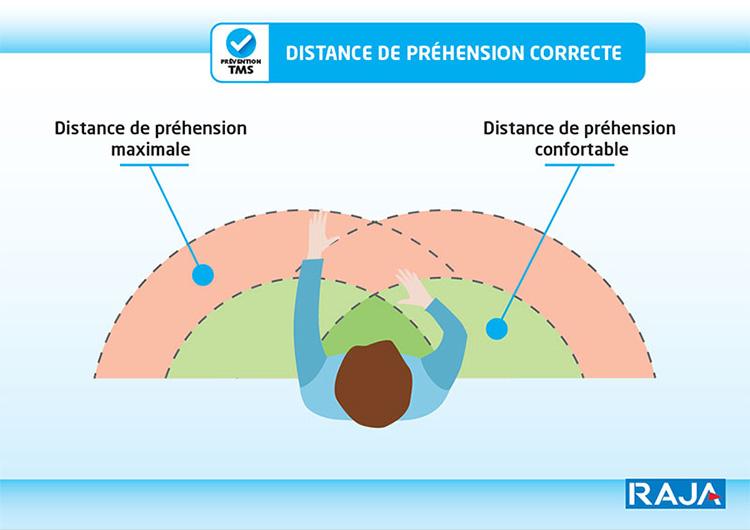
► 4. Reduce vertical grip distance
Lifting goods above shoulder height often proves to be very taxing on the back and shoulders. If you need to place a product in (or remove it from) a high shelf, use a foldable step stool or a stool step stool. This way you can easily reach the height or “vertical grip distance”. The same ergonomic principle is applied to open-front pallet boxes. You don’t have to lift your goods unnecessarily to reach the edge of the box.
► 5. Make it easy to lift and move heavy objects
Be sure to move heavy objects only the shortest distance possible. You can get help from rolling warehouse equipment such as a electric pallet truck or a high lift pallet truck. It will do all the work for you. The lift table is a particularly handy variant. You first lower the lift table to its lowest position to lift your goods. Then you use the foot pump to raise the table to the right height. Because you don’t have to lift as high, you save your back considerably. Finally, thanks to the wheels, you can easily move your goods.
Please note: rolling stock should preferably be pushed with both hands. It is generally not recommended to pull your load. Finally, consider these points when lifting objects:
- [1]Frame the load with both feet.
- [2] Bend the knees.
- [3] Maintain the natural curve of your back.
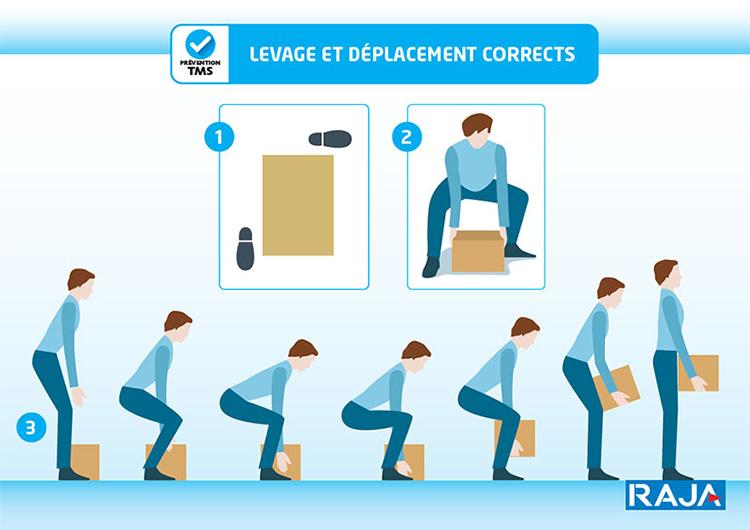
► 6. Automate your workflow
Why not let the machines do it? They are perfect for heavy work or repetitive tasks. This way you avoid a lot of physical effort and save valuable working time. Here are some frequently cited examples:
.
- Conveyors: ideal for moving an endless series of boxes. It saves warehouse workers from moving
- Pallet wrapper: with this machine, you can wrap your pallets without any physical effort. With such a stretch wrapper or banding machine, you also avoid waste, because the machine knows how much stretch film you need.
- Crate Sealer: as the name suggests, this machine seals the crates endlessly. This means that your employees no longer have to do any physical work and a lot of repetitive work is eliminated.
.
► 7. Regularly change your position and stay in motion
Taking sufficient breaks to walk, alternating between standing and sitting work… all contribute to good blood flow. Anyone who has to work standing for long periods of time can benefit from a anti-fatigue mat. The technique behind this mat is both simple and ingenious. An anti-fatigue mat has a grooved structure with studs. This subtly creates an uneven surface that encourages the feet and legs to keep moving. This can therefore enhance blood circulation.
.
The high stool or sit-stand chair is an additional ally. With this type of chair, you can very easily move from a sitting to a standing position. Thanks to the gas spring under the seat, you can adjust the height in no time.
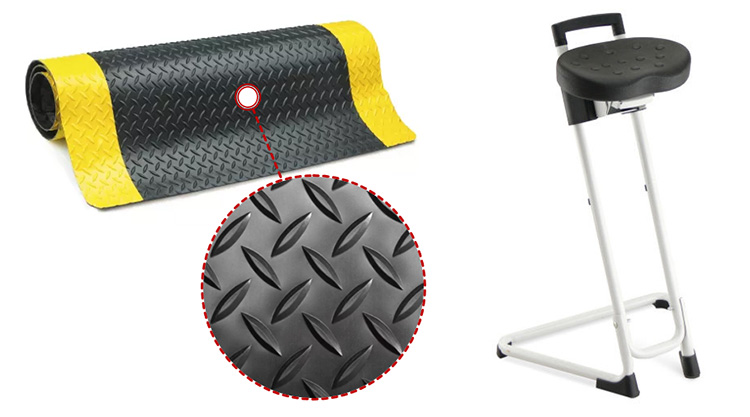
► 8. Use materials that make your work easier
A number of products are designed to reduce pressure on joints and muscles. So they can make your job a lot easier. Let’s take a look at some of the popular tools that can help prevent MSDs:
- Aluminum Handhelds: these models are much lighter than standard models. This makes them more ergonomic and less effort to move goods.
- Safety knives: look for those with an ergonomic handle. This ensures a better grip and makes cutting easier. These knives are usually very safe, as the blade is retractable or protected.
- Fringe press: instead of wringing out your fringe by hand, use the press. This is much less strain on the wrists.
- Pre-stretched film: this type of stretch film requires much less effort to wrap a pallet.
► 9. Wear appropriate work clothes
Clothing doesn’t just make the man – it can also help prevent MSDs. Make sure your employees wear work clothes that are appropriate for their size and working conditions. Among other things, it is important to wear flexible clothing that does not restrict movement. As far as personal protective equipment is concerned, the following clothing and tools should be taken care of:
Personal protective equipment
- Protective gloves that fit your hand and wrist. To help you choose the right pair, use this glove size guide.
- Foldable dust masks: they generally fit the face better. A dust mask with a valve also reduces exhalation resistance and lowers the CO2 content, humidity and temperature inside the mask.
- Safety shoes without metal parts: much lighter and comfortable to wear. Add to that a flexible outsole and you have shoes that can be worn for hours in a warehouse.
- A hearing protection is essential if you work in an overly noisy environment. Please note that the limit for hearing damage is 80 dB.
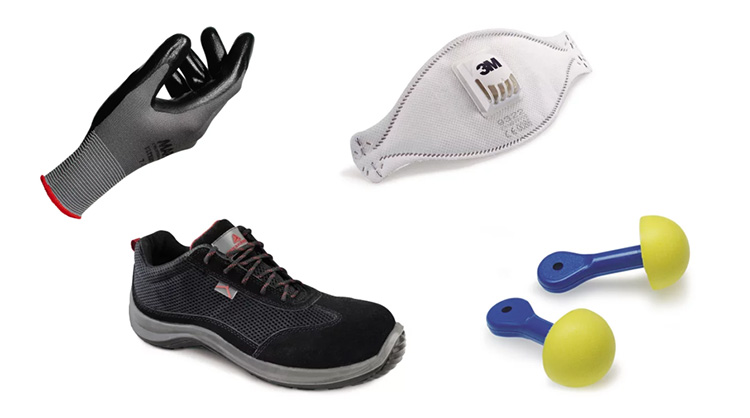
► 10. Keep the temperature under control
Freezing cold in winter, scorching hot in summer… In a warehouse, temperatures can fluctuate wildly. Did you know that a working environment that is too hot or too cold can lead to RSI? So keep an eye on the weather forecast and anticipate extreme conditions. In some previous articles, we have already compiled guidelines to follow to keep work enjoyable even in very high temperatures or very low.
Sources:
www.preventiondestms.be/fr
www.emploi.belgique.be/fr/themes/bien-etre-au-travail
www.beswic.be/fr/themes/ergonomie/lergonomie-pour-reduire-la-charge-physique-et-les-tms
www.ergonomiesite.be/computerwerkplek














